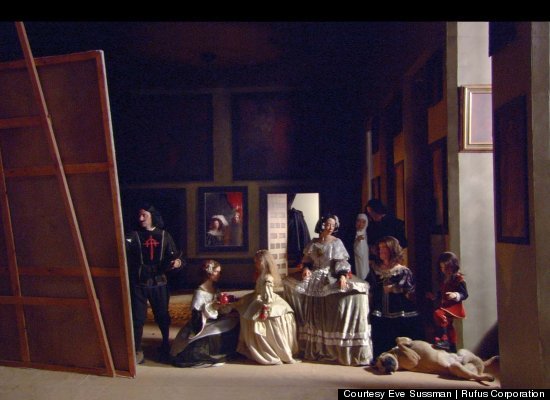ISEA12 Albuquerque
ISEA2012 Machine Wilderness
As contradictory as it sounds to hold a conference/exhibition on ecology in a remote location among the fragile sands of New Mexico, ISEA12 had an ecological theme "Machine Wilderness". The associated air miles and car use were the unfortunate overheads. Outstanding works included François Quévillon's Derive (video) which visualised weather data embedded in the drawing of a reactive 3D graphic landscape. It was remarkable in its subtle rendering and potential for showing data in intuitive ways.
Other top works included The Hand of Man in Taos,
 |
| The Hand of Man-Christian Ristow |
Teri Rueb, Carmelita Topaha & Larry Phan: No Places with Names: A Critical Acoustic Archaeology locative wilderness walk has already been blogged here, but Charles Lindsay: CARBONX Dome piece also at Sante Fe, was another overwhelming experience.
The Sante Fe day included a visit to SITE whose More Real? Art in the Age of Truthiness show was a knock out-albeit not particularly electronic ( In collaboration with the Minneapolis Institute of Arts. The
exhibit will be on display until January 6th, 2013.)
 | |||
| Eve Sussman video still from "89 Seconds at Alcázar"Los Meninas | . |
For me the out standing works were artist Inigo Manglano-Ovalle's replica of the chemical-weapon-baring trucks Colin Powell recollected from Iraq. And others focused more heavily on the technological advancements that blurred the line between documentation and reappropriation, such as Eve Sussman's video installation that recreates the scene of Diego Velazquez's "Las Meninas."
| 50/50 Native Artists in Sa |
This exposed the contradictory nature of the whole event: sensitive eco-friendly projects addressing the despoiling of the wilderness by man's careless interventions, at the same time endorsing low rider and car-centered cultures in the region, and very little said about the grab for oil, the arctic sea ice melting the move away from nuclear and the terrifying future that global warming will bring. It was not complacent, but seemed far from the European consciousness about the global climate crisis and tthe radical changes needed.
 |
| Steve Storz Kanobis Amplifier Research Facility |
On Taos day the sinister shed by Steve Storz Kanobis Amplifier Research Facility (KARF) Phase II
at the UNM Klauer Campus in Taos NM, was an
outdoor electronic sculpture installation that underlined the complicity
of scientists in despoiling this pristine landscape in the name of
'freedom'.
However
the focus on building DIY adobe shacks at Taos seemed nice and
hippyish, but is not a realistic long-term solution. Engaging with Los
Alamos was also a nice idea, but the attitudes revealed at the Sante Fe
conference by the artistic director, implied a massive misunderstanding
of the role of art: seeing it only as a way of illustrating existing
scientific materials more effectively, rather than as a radical way of
completely rethinking methodologies.
The small contribution we made as a team ( Nina Yankowitz, Barry Holden , Martin Rieser, Rasmus Vuiori) was an interactive questionnaire using QR codes to probe the contradictions in people's attitudes to Eco issues. The resulting web database will be used to drive future online interventions using avatar humour to engage a thoughtful response to the crisis.
The main exhibition for ISEA2012 was displayed at a total of seven venues. It is based at both The Albuquerque Museum of Art & History and 516 ARTS, with off-site projects at the following five Anderson-Abruzzo Albuquerque International Balloon Museum, the New Mexico Museum of Natural History, the Rainosek Gallery at the UNM School of Architecture & Planning, Richard Levy Gallery and the Alvarado Urban Farm. The exhibition features work that combines art, science and technology, demonstrating the role art can play in re-envisioning the world. The over 100 artists are from 16 countries: Austria, Brazil, Canada, Finland, France, Germany, Italy, Korea, Mexico, The Netherlands, New Zealand, Portugal, Scotland, Spain, the U.K. and the USA. The exhibition was juried and curated through an international call for proposals, which drew close to 1,500 submissions from artists and presenters around the globe. The exhibition is accompanied by a catalogue published by the acclaimed Radius Books, which will be distributed internationally.
It
was a massive attempt to integrate electronic arts and the ecologic
movement and as such deserves praise for both ambition and achievement.
Posted 11 hours ago by Martin Rieser


